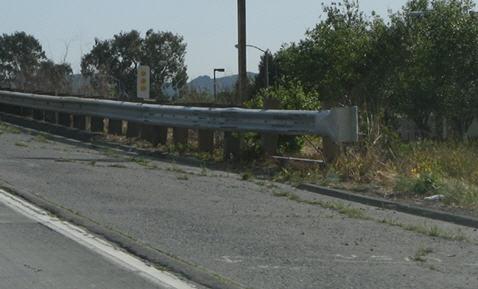
Labor Intensive Manual Tasks
Link to pdf here.
| Outcome | Engineering based recommendations of cost-effective deployable improvements to methods, equipment, and processes in roadside vegetation control. |
| Benefit | Reduce worker injuries and associated cost, improve roadside maintenance operations. |
AHMCT is researching the roadside maintenance work environment to identify cost-effective deployable improvements to methods, equipment, and processes that will lessen worker injuries, increase worker effectiveness and support Caltrans goals of safety and stewardship.
Why We Are Pursuing This Research

Caltrans effort to maintain and control vegetation along roadsides has been severely affected by the effort to reduce the use of herbicides and meet storm water quality requirements. As a result, mowing efforts have increased and more manual work is required to control the growth and spread of vegetation. Most of the present day solutions to vegetation control without herbicides demands the use of hand carried tools which is inherently more hazardous. Finding alternative solutions is the primary challenge.
What We Are Doing
This project will review the vegetation control work in Caltrans Activity Families C and E and will be focused on developing machine based solutions that will improve Caltrans worker safety and effectiveness. At the end of the project, AHMCT will report conclusions that will make recommendations for improved equipment and methods using engineering based comparisons of benefits and costs.
Initial research has been directed toward three vegetation maintenance scenarios that are significant challenges. A common characteristic to these three scenarios is the proximity to the travel way. Vehicles and crews working in these area are closer to the hazards of traffic and closure of the adjacent traffic lane is undesirable.

The three scenarios are:
A. Clearing vegetation around posts & guardrails.
Mowing is significantly hindered by the posts and guardrails on roadsides. In landscaped areas plantings are similar obstacles. Weed control in this area requires significant manual efforts if herbicides are not used.

B. Maintenance of the fire and mow strip.
This area is typically 4 to 8 ft wide and located off the edge of the shoulder pavement. Usually bare dirt or gravel, keeping this area clear, reduces fire starts, hinders plant growth in the pavement, and slows the migration of noxious weeds along road corridors.

C. Removal of vegetation growing on pavement.
Vegetation growth on paved surfaces is damaging to the roadway and unaesthetic. Sweepers will not easily clear these out without previously killing the plant with herbicides.
Each scenario has unique characteristics that will test the flexibility and applicability of a vegetation control method. Presently, herbicide spraying and mowing are being compared with three alternative vegetation control methods – hot foam application, radiant heating, and high pressure water application – in each of the three scenarios. Calculations are also based on estimates for the theoretical performance of automated roadside versions of each alternative technology.

As a result of investigations to date, other specific solutions to scenarios have been found and will be recorded. A solution to the challenge of eradicating Pampas grass has been demonstrated using a novel systems such as the CAMCO HMO system which has potential application in other scenarios.
Current Status
AHMCT reviews results with various expert parties in Caltrans and other organizations and pursues investigations in the field to further refine the comparison and evaluation process. Further work might include investigation of using other machine concepts including tools that can be integrated into an ARDVAC type machine.
AHMCT is preparing a full presentation of the material to Caltrans in the next few weeks. A web based toolbox is being recommended for effective sharing of information.
For Additional Information
| Bob Meline Caltrans Project Manager |
bob_meline (at) dot.ca.gov | (916) 227-7031 |
| Steven Velinsky Principal investigator |
savelinsky (at) ucdavis.edu | (530) 752-4166 |
| Wil White Primary contact |
wawhite (at) ucdavis.edu | (530) 752-1455 |
This document is disseminated in the interest of information exchange. The contents do not necessarily reflect the official views or policies of the AHMCT Research Center, the University of California, the State of California, or the Federal Highway Administration. This document does not constitute a standard, specification, regulation, or imply endorsement of the conclusions or recommendations.
(rev. May 2007)
